What Are The Best Fabrics For Smocked Children’s Clothes
Fabrics encompass a wide range of materials, both natural and synthetic, and the number of fabrics is practically infinite as it continues to expand with technological advancements and innovations in textile manufacturing.
In today’s world, stepping into a clothing store can be overwhelming due to the multitude of options available, with trendy fashion designs and diverse fabric choices. Even if you’re not well-versed in textiles, it can be challenging to distinguish between two fabrics that may have slightly different compositions.
This becomes more important when it comes to children. Choosing the right fabric for your child’s clothing requires careful consideration of various factors. But don’t worry, we’re here to help!
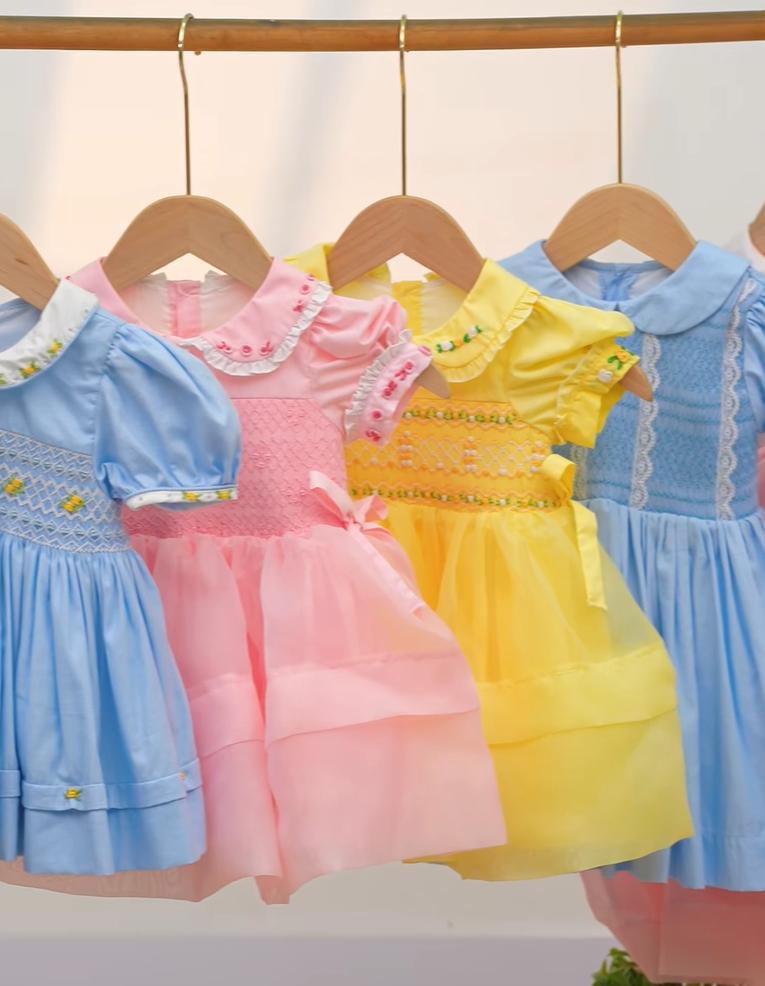
Factors to Consider When Choosing Fabrics
The difficulty is here, you touch the product and find it quite good, but that is not the factor for you to decide to buy smocked children’s clothes. You will need to consider the following additional factors:
- Comfort and breathability
It’s important to choose fabrics that are comfortable for your child to wear. Look for materials that are soft against the skin and allow air to circulate, keeping your child cool and preventing discomfort.
- Durability and Ease of care
Kids can be active and messy, so it’s essential to choose fabric that can withstand their “adventures.” Choose fabrics that are durable and easy to wash, helping parents save time and effort in preserving clothes.
- Safety Considerations
When choosing fabrics for children, safety is the top priority. Make sure the fabric does not contain toxic substances and chemicals that can irritate the skin or cause allergies. Fabrics that can cause irritation to children are spandex, poly, rough jeans, and fabrics with many dyes.
Therefore, stay away from these fabrics and look for fabrics that are hypoallergenic and meet safety standards to ensure your child’s health.
Best Fabrics for Smocked Children’s Clothes
Cotton: Softness, versatility, and breathability
Cotton is a natural fabric that comes from the cotton plant. It is widely used in clothing because of its softness and comfort. Some variations of cotton can be named Gingham fabric, knit fabric, seersucker fabric, etc.
Cotton is an excellent choice for smocked children’s clothes due to several reasons.
- Incredibly soft, which ensures that your child feels comfortable and cozy while wearing it.
- Cotton is a breathable fabric, meaning it allows air to circulate, preventing your child from feeling too hot or sweaty. This is especially important for active kids who love to play and move around.
- Cotton is gentle on the skin and less likely to cause irritations or allergies, making it suitable for children with sensitive skin.
- Cotton is a versatile fabric that can be easily smocked and holds its shape well, allowing for beautiful and intricate smocking designs to be created on children’s clothing.
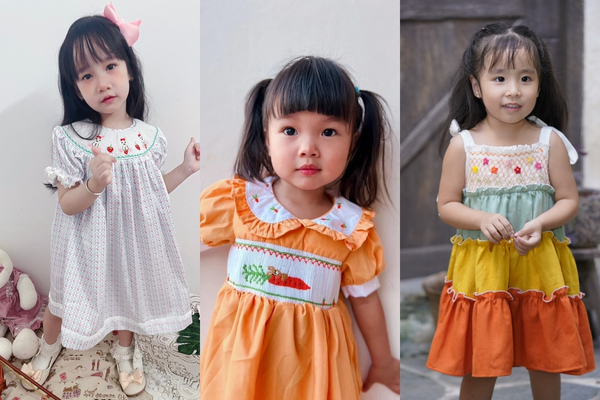
And this is also the type of fabric that K-Embroidery mostly uses for smocked children’s clothing. Although the price for this fabric is quite high, all of our products are guaranteed to be 100% cotton simply because we care about our customers. That’s why we have a saying that goes, “Don’t count the positive feedback about us; it will be easier to count the negative ones because we don’t have any.”
We are always ready to take you on a tour of our factory, from the fabric selection process to the final quality control stage. So, if you want to surprise your daughter with adorable smocked dresses, you know who to turn to.
Linen: Lightweight, cooling, and natural texture
Linen is a natural fabric made from the flax plant. It has been used for thousands of years and is known for its cool and lightweight properties.

Why is linen an excellent choice for smocked children’s clothes?
- Lightweight, which means it won’t weigh your child down or make them feel too hot, especially during warmer seasons like summer. Linen has natural breathability, allowing air to flow through and keeping your child cool and comfortable.
- Has a unique texture that adds a touch of natural charm to smocked designs. It gives a relaxed and casual look while still looking stylish.
- Linen is a durable fabric that can withstand active play and frequent washing, making it ideal for children’s clothing that needs to endure everyday wear and tear.
Linen is a fantastic choice for smocked children’s clothes, offering a combination of comfort, breathability, and a lovely textured appearance.
Bamboo: Eco-friendly, moisture-wicking, and hypoallergenic
Bamboo fabric is obviously made from the pulp of bamboo plants. It is a natural and sustainable material that is becoming increasingly popular in the textile industry.
Why is it best for smocked children’s clothes:
- It is eco-friendly because bamboo plants grow quickly and require fewer resources compared to other plants used for fabric production. Choosing bamboo fabric helps support sustainable practices.
- Bamboo is moisture-wicking, meaning it can absorb and evaporate moisture quickly. This helps keep your child dry and comfortable, especially during active play or in warmer weather.
- Bamboo fabric is hypoallergenic, which makes it suitable for children with sensitive skin or allergies. It is less likely to cause skin irritations or reactions, providing a gentle and safe option for smocked clothing.
Modal: Silky smooth, stretchable, and color retention
Modal is a type of fabric made from beech tree fibers. It is known for its soft and silky smooth texture.
Modal fabric is an excellent choice for smocked children’s clothes for a few reasons.
- Incredibly smooth and luxurious against the skin, providing a comfortable and pleasant wearing experience for your child.
- Stretchable, meaning it can move and stretch with your child’s body, allowing for freedom of movement and play.
- Excellent color retention properties, which means the vibrant colors of smocked designs will stay bright and vibrant for a long time, even after multiple washes.
Silk: Luxurious and Shiny
Silk is a natural fabric that is made from the fibers produced by silkworms. It is known for its luxurious and shiny appearance.
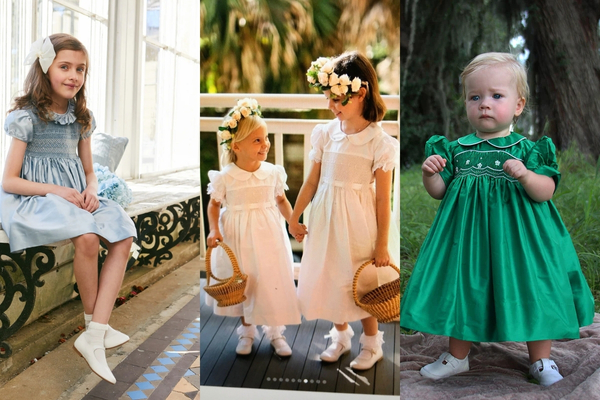
Silk is considered a great choice for smocked children’s clothes for a few reasons.
- It has a luxurious feel and a beautiful sheen that adds an elegant touch to the garments.
- Silk is a lightweight fabric that drapes well, providing a comfortable wearing experience for children.
- Silk also has natural temperature-regulating properties, which means it can help keep children cool in hot weather and provide warmth in cooler temperatures.
Blends: Combining fabrics
Blends refer to fabrics that are made by combining two or more different types of fibers. These fibers can be natural (such as cotton or linen) or synthetic (such as polyester or spandex). However, parents should ensure that their children are not allergic to these fabrics.
Blended fabrics are often used in smocked children’s clothes because they offer enhanced benefits by combining the positive qualities of different fibers.
- For example, a blend of cotton and polyester can provide the softness and breathability of cotton while adding durability and wrinkle resistance from polyester.
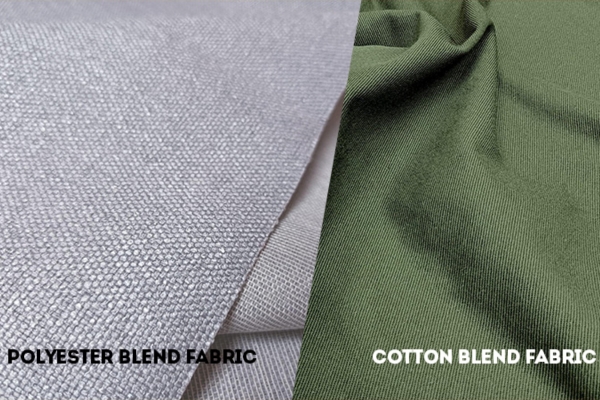
Blended fabrics can also offer improved stretch and flexibility, making them more comfortable for active children.
- For instance, a blend of cotton and spandex can provide a good amount of stretch, allowing for greater freedom of movement.
Moreover, blended fabrics can offer better color retention, shape retention, and resistance to shrinkage compared to single-fiber fabrics. This means that smocked designs on blended fabrics will stay vibrant and the clothes will maintain their shape and size even after multiple washes.
Many garment factories also commonly use this type of blended fabric for their children’s clothing products. However, it’s not worth mentioning if they don’t clearly state that their products are 100% cotton or 100% linen just to increase the price and make more profit. When customers buy those products, they often feel dissatisfied and notice the difference between the description and the actual product.
Fabric Care Tips and Recommendations
Proper care and storage of children’s clothing with jackets is essential to ensure longevity and preserve their appearance. You don’t want to throw away a torn dress just because you didn’t read the instructions carefully.
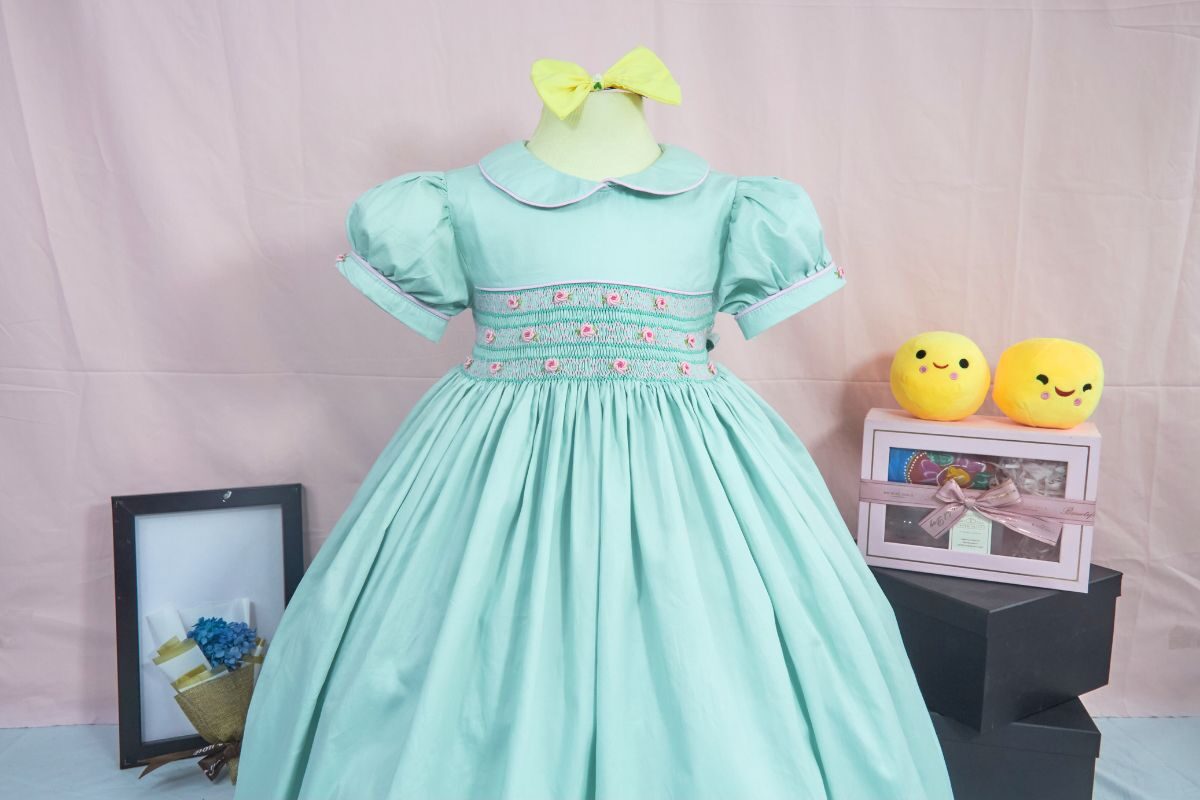
Washing and drying guidelines
- Sort by color and fabric: Sort outerwear based on color and fabric type before washing. If your beautiful white dress gets stained with the color of another outfit, it will be a nightmare.
- Read the care label: Always check the care label on your baby clothes that include outerwear for specific washing instructions. This will guide you on temperature, appropriate washing method (hand wash or machine wash) and any other special care requirements.
- Use gentle detergents: Choose gentle and gentle detergents specifically designed for delicate fabrics. Strong detergents can fade colors or damage fabrics.
- Wash with care: If machine washing, use gentle or gentle cycle with cold water. If washing by hand, gently rinse the garment in a sink of cold water and mild detergent.
- Avoid excessive agitation: Be gentle when washing and avoid vigorous rubbing or wringing the garment as this can distort jacket designs and damage the fabric.
- Air dry or tumble dry on low heat: Children’s outerwear is best dried by laying them flat on a clean towel or hanging them to dry. If using a dryer, choose a low temperature setting to avoid shrinking or damaging the fabric.
Handling delicate fabrics
- Handle with clean hands: Before touching delicate fabrics, make sure your hands are clean to avoid getting dirt or oil on your clothes.
- Avoid sharp objects and rough surfaces: Use caution when wearing or handling delicate fabrics to avoid snagging or tearing by sharp objects or rough surfaces.
- Store properly: When storing clothes made of thin fabric, fold them neatly and place them in a clean, dry place. Avoid hanging them on hooks or sharp hooks that can damage the fabric.

Stain removal techniques
- Act quickly: Treat stains promptly to prevent them from adhering to the fabric. Blot or gently blot the stain with a clean cloth or paper towel to remove excess liquid or residue.
- Test on an inconspicuous area: Before using any stain remover or cleaning solution, test it on a small, inconspicuous area of the fabric to make sure it does not cause discoloration or damage. broken.
- Follow specific stain removal instructions: Different stains may require different treatment methods. Refer to the care label or refer to the stain removal instructions for specific instructions on how to treat different types of stains.
- Blot the stain, don’t rub it: When applying stain remover, gently blot the stain with a clean cloth or sponge. Avoid rubbing vigorously as this may spread the stain or damage the fabric.
Conclusion
Choosing the right fabric for smocked children’s clothes is a difficult task for their comfort, durability, and overall aesthetic appeal. Fabrics like cotton, linen, modal, blends, silk, and others offer unique qualities that make them ideal for smocked designs, ensuring that your little ones can look stylish and feel great in their adorable outfits.


